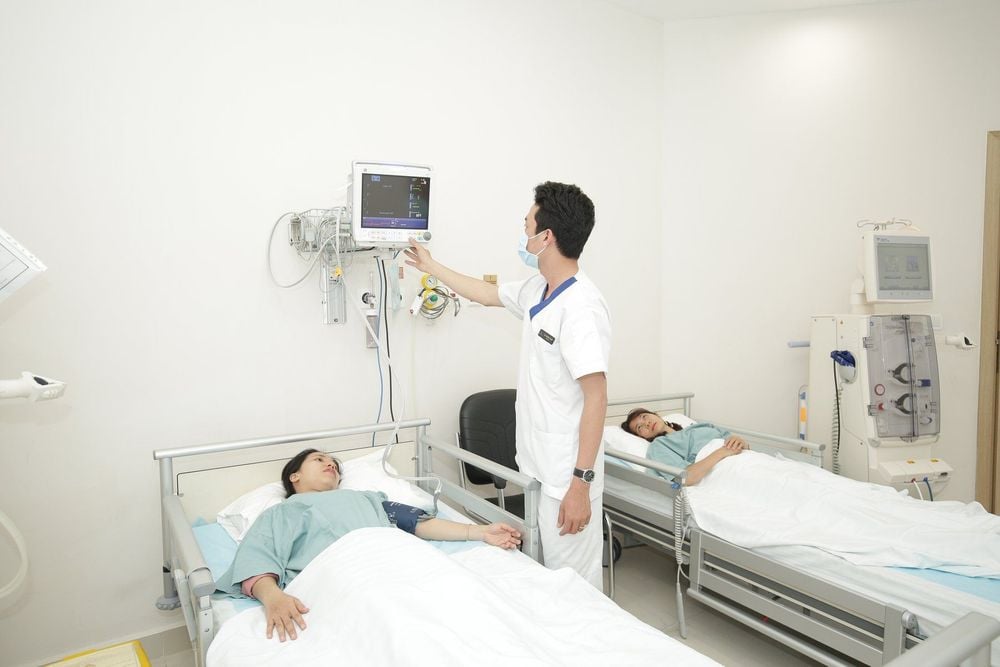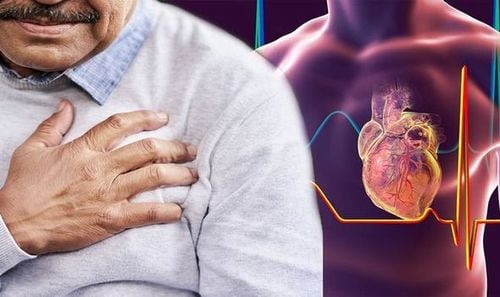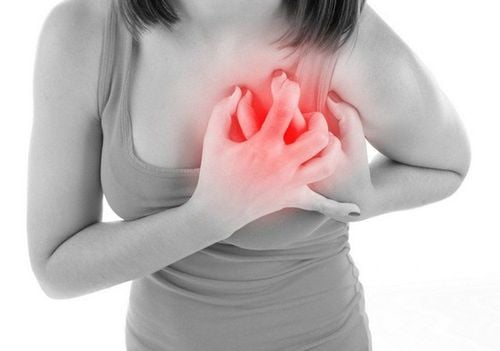This is an automatically translated article.
Posted by Master, Doctor La Thi Thuy - Interventional Cardiologist - Cardiovascular Center - Vinmec Central Park International General Hospital
Mitral valve stenosis is one of the serious heart diseases over time, when the heart valves are attacked and deformed by immune complexes. However, mild mitral stenosis often has few clinical manifestations, only when it is detected by laboratory examination, most of them have progressed to the severe stage leading to heart failure.
1. Overview of mitral stenosis
Mitral stenosis is a fairly common disease in our country accounting for about 40.3% of acquired heart diseases. The disease was born in humans from the beginning of living in populations due to poor living conditions, cramped, and unsanitary conditions that easily cause disease transmission. From 1887 Bouillaud then Sokolski described the disease. In 1920 Duckett Jones (USA) studied this disease and in 1944 he published seven diagnostic criteria. In the same year, Cutter and Levine Phillipe (USA) tried to operate mitral stenosis and in that year Souttar in England also operated mitral stenosis. At this stage, mitral stenosis is the most common cardiovascular disease, causing a lot of disability and death. Since 1944, the invention of Penicillin to kill streptococcus species and especially the slow creation of Penicillin (Benzathyl Penicillin) has a preventive effect on this disease. So far in developed countries such as Sweden, the Netherlands and Germany, the disease has spread. rheumatic heart disease almost disappeared.
However, in less developed countries this disease is still common. The disease is common in working age from 20 to 30 years old, the rate of mitral stenosis is very high, about 60-70%, the mortality rate is 5%. The disease has many complicated complications and leads to disability. The disease is more common in women than men (3/1) and more common in rural areas than in urban areas.

Bệnh hẹp van 2 lá là bệnh thường gặp liên quan đến bệnh tim
2. Original tendon causes mitral stenosis
The main cause of mitral stenosis is 99% rheumatic heart disease, the rest is congenital, or due to malignant carcinoid, systemic lupus erythematosus, rheumatoid arthritis, some studies also suggest that caused by the Coxsackie virus. The main causative agent of the disease is group A hemolytic streptococci, which causes pharyngitis and rheumatic heart disease. The reason strep throat causes rheumatic heart disease but does not enter other organs is because there are lymphatic passages between the throat and the heart. Fetal structure shows a vascular and nerve junction between the heart and the neck.
In 1976 Taranta (USA) demonstrated the direct pathogenesis of streptococcal toxins on the heart. Anti-cardiac antibodies are present in patients with rheumatic heart disease with heart inflammation, with both cardiac structure cross-antigen and A streptococci. In summary, the pathogenesis is as follows: group A streptococcus. enter the body causing sore throat and produce toxins. In addition, in the heart tissue, people also find materials with an immune structure similar to the M protein, so antibodies are also formed against the heart valves.
Autoimmune crossover mistakenly causes heart inflammation and arthritis. Heart inflammation can resolve on its own, but after 2 years it can leave sequelae in the heart valves, 1 in 3 patients will have sequelae in the heart valves such as fibrous thickening, causing narrowing of the heart valve.
3. Clinical and subclinical symptoms of mitral stenosis
3.1. clinical
Body as a whole: If the disease is diagnosed before puberty, the patient is underdeveloped physically, called "nanisme mitral". If it occurs after puberty, the child develops almost normally. Function: Sometimes discovered incidentally by mass physical examination, the patient has no symptoms even with exertion. Sometimes patients go to the doctor because of shortness of breath, coughing up blood, palpitations, palpitations, choking due to atrium pressure on the esophagus, especially during exertion. , lying on the left side or sometimes right for the patient to do strenuous movements. Typical mitral stenosis usually hears the following symptoms according to frequency. A sharp, apical T1 sound (due to the pulsation of thick fibrous valves). Diastolic fibrillation (RTTr): At the apex due to narrowing of the valve, the blood flow is forcefully pushed down the left ventricle, hitting the muscle columns and muscle bridges in the left ventricle with scleritis, calcification or loss of RTTr when the valve is narrow, the valve and the organ Subvalvular function thickened, calcified, and adherent. Strong T2 at the base of the heart due to an increase in pulmonary artery pressure because the two aortic and pulmonary valves do not close at the same time, resulting in a split T2 (pulmonary valve closes later than the aortic valve). Pre-systolic murmur in the middle of the heart or at the apex due to blood flow through the narrowing area if there is still stasis in the left atrium, the left atrium must squeeze again to push the remaining amount of blood into the left ventricle; but when there is atrial fibrillation or left atrial dilatation, the pre-systolic murmur is no longer heard Apical or intra-apical mitral opening clac. This sound only occurs when the valve is still soft. When the pulmonary artery pressure is high, the right ventricle dilates a lot, causing the pulmonary valve ring to dilate, causing a diastolic murmur in the pulmonary valve called a Graham-Steel murmur. There are also cases of mitral stenosis that can't be heard on examination, but thanks to complications and thanks to the most subclinical ultrasound, called "dumb" mitral stenosis

Khó thở là triệu chứng phổ biến của bệnh hẹp van 2 lá
3.2 Subclinical
Chest X-ray: There are 2 positions to probe in mitral stenosis:
Straight position:
Right side: Left atrium enlarged to the right usually has 3 stages. Stage 1: The left atrium is enlarged, forming 2 parallel arcs with the inner border being the left atrium, the outer border being the right atrium. Stage 2: The large left atrium extends to cut the right atrium, forming two intersecting arcs. Stage 3: Large left atrium protrudes outward to form 2 parallel arches in which the outer arch is the left atrium and the inner arch is the right atrium (in contrast to stage 1). Left side: There are 4 arches: aortic arch, pulmonary artery arch, left atrial appendage arch, left inferior arch with apical elevation (right ventricle large).
Pulmonary hilum: Dark, forming on both sides of the heart shadow two wide spaces and unclear boundaries. The two lung fields are blurred due to blood stasis, Kerley B can be seen. If there is active pulmonary hypertension, the hilar area is dark and the lung margins are very bright.
On slant film with barite intake: esophagus is compressed in the middle third. Loss of light space in front of the heart or behind the sternum (large right ventricle).
Electrocardiogram:
In the early stage, there is no narrowing or much influence on the heart chambers: the electrocardiogram is still normal. Later stage: Left atrial thickening with P (0.12s or biphasic P, negative phase greater than (+) phase in V1. Right electrical axis deviation and right ventricular thickening, arrhythmia can also be seen. such as atrial extrasystoles, atrial tachycardia, atrial fibrillation are the most common, may have incomplete right bundle branch block
Echocardiography:
Is the definitive diagnostic tool for mitral stenosis, especially when Clinically undetectable mitral stenosis Ultrasound also allows us to assess the thickness of the valve and subvalve tissue so that we can decide whether to replace or separate the valve
In simple stenosis:
2D: Valve The anterior and posterior leaflets are fused together, so they move parallel to the same direction, the leaflets thicken. The valve is shaped like a plateau or snowshoes. The diastolic gradient EF is reduced. If narrow, the diastolic gradient can be decrease <15 mm/s Left atrial diameter increases Right ventricular diameter increases, right ventricular septum thickens Visible signs of indirect pulmonary hypertension
Doppler ultrasound:
Can detect valve stenosis two leaves that are associated with the t other injuries to have an appropriate treatment attitude. Simultaneously measure pulmonary artery pressure, monitor pulmonary artery pressure before and after treatment.
Transesophageal echocardiography:
Find a thrombus in the left atrium, if it is detected, the valve will not be dilated
4. Treatment of mitral stenosis
Treatment of mitral stenosis can be treated with medical therapy, percutaneous balloon dilatation or valve replacement surgery Medical treatment: Avoid exertion May use beta-blockers if the heart rate is tachycardic to reduce Heart rate Use vitamin K antagonist anticoagulation when there is atrial fibrillation, history of embolism, left atrial dilatation >55 mm or thrombus in the left atrium. Maintain INR from 2.0-3.0 Percutaneous balloon dilatation: The first-line measure if the patient has indications for intervention. This technique will insert the catheter through the femoral vein into the right atrium, then through the atrial septum to the left atrium, down to the mitral valve. Then the ball will be inflated to separate the two valve edges. Angioplasty is indicated when mitral stenosis is constricted (valvular orifice area less than 1.5 cm2) and has clinical symptoms, appropriate valve morphology, no thrombus in the left atrium, and no associated mitral regurgitation. , or regurgitation of the aortic valve is moderate and has not affected left ventricular function. Surgery: Mechanical or biological mitral valve replacement when dilation is not possible or is contraindicated. Mechanical valves are more durable than biological valves, but after replacing mechanical valves, vitamin K antagonists must be used for life. If you have mitral stenosis, you need to see a cardiologist to determine if surgery is necessary, and then choose the surgical approach that best suits your individual needs. Early diagnosis and thoughtful cardiovascular care can help patients with mitral valve stenosis live a healthy, near-normal life.

Bệnh viện Đa khoa Quốc tế Vinmec là địa chỉ uy tín để khám và điều trị bệnh hẹp van 2 lá
Vinmec International General Hospital is the address for examination, treatment and prevention of diseases, including cardiovascular diseases. When performing the cardiovascular screening process at Vinmec, customers will be welcomed and used the modern facilities and equipment along with perfect medical services under the guidance and advice. of well-trained doctors both at home and abroad.
Customers can directly go to Vinmec Health system nationwide to visit or contact the hotline here for support.













